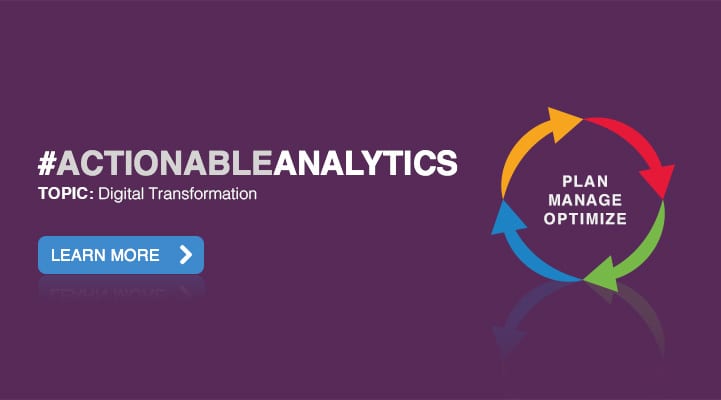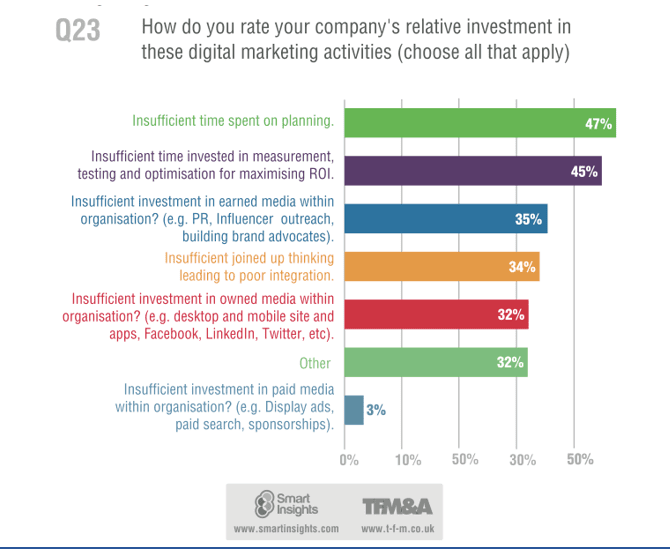Evolution, not revolution is the pragmatic approach to Digital Transformation

Businesses of any scale can generate huge quantities of data from their analytics – most of it with the potential to improve performance. But to realize that potential, to action the actionable takes time, focus and budget.
This research from the Smart Insights Managing Digital Marketing report shows that many businesses are conscious that they are not spending sufficient time on planning and optimization.

In organisations who have yet to embrace data as a vital marketing tool, getting buy-in for the resources to make it happen can be challenging to say the least.
As a digital transformation specialist, I often work with people at the start of their journey to a digital direct-sell business model. For them it represents a major cultural shift requiring new skills, techniques and competencies.
Many of these have traditionally sold their products through distributors and agents and therefore lack digital or direct to customer marketing DNA in the Board room. This means that their experience of the power of actionable analytics is limited and a Kaizen marketing approach is as alien as it sounds.
Getting business leaders to engage
So how do you get business leaders engaged with the data and use actionable analytics to drive transformation?
In my experience, the approach needs to be one of evolution rather than revolution. In practice that means a step by step approach, taking persuasive and focused actionable analytics to the Board room one by one; using a series of mini business cases to win the resource to take action, rather than flooding the business with a blizzard of data and large resource requests it’s not ready for.
The first step is the hardest
I was working with a SME business recently that was starting out on the journey to digital transformation. The marketing team were finding it difficult to win more resource to develop business as usual tasks such as an ongoing programme of conversion optimization. They had tried several times to secure the budget, but had struggled to get buy-in from the board.
They had built an impressive presentation featuring lots of diagrams, funnels and actionable analytics. But somewhere in all that great diagnostic data the key message had been lost.
Show them the money
So we worked together to simplify the business case and focus on 3 scenarios.. These showed that if we increased conversion by various amounts we would make £X incremental revenue from the same amount of traffic.
The commercially focused headline figures got the attention of the key Directors. Having shown the size of the prize, we were then able to have the conversation about the resources required, the costs and projected ROI. The budget was signed-off.
Step by step. Little by little.
This initial step opened the door to further conversations on how we could use actionable analytics to iteratively improve performance and begin to make the shift to agile budgeting, responsively shifting resource into the best performing digital channels with the highest ROI.
We identified that although 40% of traffic was coming from organic search, the bounce rate was very high and conversion was relatively low, prompting a project to review their SEM activity. Momentum was building and the evolution towards a data-driven culture was accelerating - all based on using basic, focused and persuasive actionable analytics to make the case.
Next we highlighted that Facebook was generating a significant and growing percentage of traffic and it was converting at well above the site average. This quickly led to another mini business case which, building on the first, successfully pitched for more content development resource. Subsequently this evolved into a full content marketing strategy.
More recently we have worked with the Board to define 5 KPI’s related to key stages of the customer journey. These are now reviewed at every trading meeting to begin embedding an actionable analytics focus within the business.
Building momentum
In that case we started with a focus on 1 key metric – the financial upside of increasing resource to improve conversion - and built from there, keeping it simple, taking it one step at a time and resisting the urge to try and connect leaders with all of the great data we had at our disposal all at once.
In my experience, these leaders were not unusual in businesses beginning their digital transformation journey. They don’t want to get under the bonnet and deal in an alien language of funnels, customer journeys and usability. They just want to know was how much more money the company will make if they invest in the resources to do it. So wherever possible, nail your colours to the mast and lead with a headline figure in cash terms to earn attention and get sign-off.
When I’ve worked with customers who have an offline direct marketing background, for example using direct mail as their main acquisition tool, the transition to wider suite of digital actionable analytics was much quicker and easier to embed. The underlying principles of acquisition and retention metrics were understood and a test, learn, improve mindset was already present.
Some things to bear in mind
But if you’re working with or within an organization where actionable analytics are not yet culturally embedded it’s useful to bear in mind the following success factors for making analytics more actionable :
- 1. Get focus. Get business leaders involved in agreeing the top 5-10 KPIs that relate to business contribution to digital channels, and signed up to a review of these at every trading meeting and in the Board room. This will lead to a deeper engagement and drive an analytics focus from the top down.
- 2. KISS. Turn your marketing skills inwards and remember to keep it simple.
- 3. Focus on the headlines. Use the diagnostic analytics to get the job done when you’ve won the resources – but keep to a minimum when making the pitch.
- 4. Deliver relevance to your internal audiences. Segment reports and insights to meet the specific needs of various functions within the business.
- 5. Take it step-by-step. It’s an iterative process of building confidence and trust in the data across the organization. Demonstrate how actionable analytics help to make strategic and resource allocation decisions easier.
- 6. Communicate. The way in which we communicate insights from analytics really matters to make them actionable.
Evolution not revolution leads to sustainable transformation
In my experience digital transformation is both a top down and bottom-up process. Yes, leaders must lead and be committed to driving their organisation to a digital-first culture. But to do this effectively they need the right information from the experts in the business - in form that is digestible and engaging from their perspective. And not all at once.
Like optimization itself, changing to an analytics driven culture is an iterative process. No one wants to take longer than necessary to deliver a transformation, but it’s the classic tortoise versus hare allegory. Winning hearts and minds and changing ingrained business habits is never an overnight process.
But taking the time to get it right, winning the buy-in, trust and confidence of your stakeholders, will help embed the data-driven ethos that lies at the heart of a digital transformation.
 Thanks to Rob Laurens for sharing his advice and opinions in this post. Rob has been helping organisations successfully transition to digital-first, direct-sell business models for 15 years. He’s worked with scores of SMEs, FTSE 100 companies and charities to define and implement the what, why and how of digital transformation. You can connect on LinkedIn and review his services at www.kaisendigital.co.uk.
Thanks to Rob Laurens for sharing his advice and opinions in this post. Rob has been helping organisations successfully transition to digital-first, direct-sell business models for 15 years. He’s worked with scores of SMEs, FTSE 100 companies and charities to define and implement the what, why and how of digital transformation. You can connect on LinkedIn and review his services at www.kaisendigital.co.uk.




 Thanks to Rob Laurens for sharing his advice and opinions in this post. Rob has been helping organisations successfully transition to digital-first, direct-sell business models for 15 years. He’s worked with scores of SMEs, FTSE 100 companies and charities to define and implement the what, why and how of digital transformation. You can connect on
Thanks to Rob Laurens for sharing his advice and opinions in this post. Rob has been helping organisations successfully transition to digital-first, direct-sell business models for 15 years. He’s worked with scores of SMEs, FTSE 100 companies and charities to define and implement the what, why and how of digital transformation. You can connect on 


